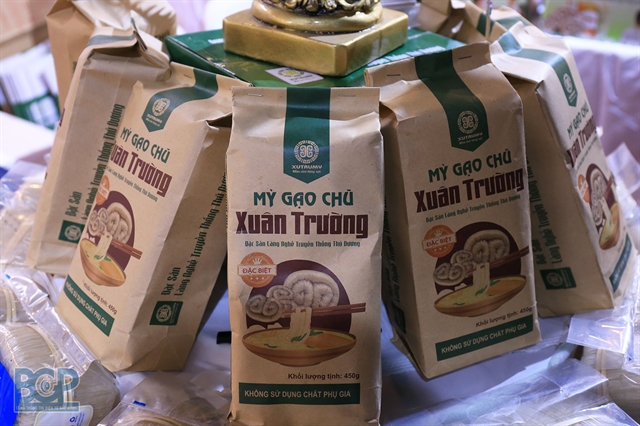 Economy
Economy


|
| Chũ noodles packages. After being repackaged, the traditional noodles' price went up to VNĐ30,000 a pack from VNĐ25,000 previously while enjoying increased popularity. — Photo courtesy of Ministry of Industry and Trade |
HÀ NỘI — Packaging played a large part in the success of One Commune One Product, a programme promoting rural communities to boost production of agricultural specialities with competitive advantages that started in 2015.
“Packaging is key to the effort to bring OCOP products to markets and consumers, especially in a time of increasing international integration,” said Đào Đức Huấn, head of the programme, during a conference to discuss ways to improve OCOP marketability and brand-building in Hà Nội last week.
Huấn said, however, not enough attention to detail remained one of the many shortcomings and limitations of the programme. Product packages were often similar in design, colour and material used. Many also failed to follow current guidelines and regulations and missing important information.
The underlying causes were a lack of technical expertise and inadequate investment on producers’ part.
He urged producers to focus on sending strong messages and creating distinctive designs for their products.
“Consumers value differences, creativity and a sense of luxury in product packages,” he said, and these are what we should be working on.”
The ideal package should be easy to produce and use while carrying a strong message for the products with clear branding and essential information.
In a survey by market research firm Nielsen, up to 67 per cent of consumers in Hà Nội, HCM City and Cần Thơ City said they placed great importance on a product’s package, saying it was the first thing that caught their attention.
There have been precedents of OCOP products that became widely popular after changing their packages. Chũ noodles, for example, experienced a surge in popularity after switching from nylon to paper bags with a new design.
“Using a more environmental-friendly material with an eye-catching design has improved Chũ noodle marketability while allowing producers to sell at a higher price,” he said.
Most OCOP products with a 4-star rating, with a 5-star rating being the highest, possess detailed packaging. OCOP products with a 2 and 3-star ratings, on the other hand, often lacked creativity and finesse or failed to focus on their brands.
Some 1-star products were said to offer no distinctive features while using generic packages, which was a missed opportunity for producers and hurt the products’ marketability.
Phạm Thị Thùy Linh, CEO of Tops Market and GO, formerly known as BigC, said there were still good products that were hindered by poor packaging, an issue that could have been addressed.
Industry experts urged producers to collaborate more with packaging businesses and to build a branding strategy to meet consumers’ demands, both inside and outside the country. Other factors to consider included product preservation, environmental friendliness and logos. — VNS




